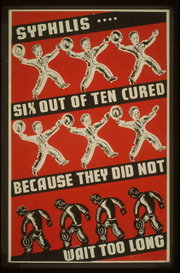The San Francisco Department of Public Health (SFDPH) is investigating several clinical failures in syphilis patients treated with the macrolide antibiotic azithromycin. This report describes the use of azithromycin for syphilis treatment, recent treatment failures in San Francisco, and CDC recommendations for syphilis treatment. Clinicians should exercise caution in using azithromycin for treating incubating syphilis or syphilis infection until the risk and mechanism of failure are better understood.
Syphilis has been increasing in the United States since 2000 and is of particular concern in San Francisco, which, in 2002, had one of the highest rates of primary and secondary syphilis in the United States. To facilitate treatment of early syphilis patients and their sexual contacts, certain disease-control programs have administered azithromycin as a single oral regimen. Several small studies have documented the efficacy of a single oral dose of azithromycin in the treatment of incubating and early syphilis infection in patients who were not infected with the human immunodeficiency virus (HIV) (1). In addition, the oral dose is more convenient to administer than intramuscular benzathine penicillin, CDC's recommended treatment for sexually transmitted diseases (2).
In April 2003, SFDPH became aware of an azithromycin failure in the treatment of primary syphilis in one patient and subsequently collected case information on this and seven other apparent treatment failures occurring during September 2002-July 2003. The median patient age was 34 years (range: 23-39 years); seven patients were non-Hispanic whites, and one was Asian-American; all were male and self-reported as homosexual. Five patients were positive for HIV, and the median number of sex partners during the 90 days preceding diagnosis was three (range: two to 100 partners; one nonrespondent among the eight patients who provided such information).
Treatment failure was well documented in three patients with ulcers (two penile and one oral). After treatment of each patient with 2 grams of azithromycin, one penile ulcer was still positive by dark-field microscopy after 5 days, one penile ulcer persisted and was dark-field positive during the next 5 weeks, and the oral ulcer worsened during the next 18 days. Five other patients who were asymptomatic, seronegative contacts to early syphilis patients received 1 gram of azithromycin but seroconverted subsequently or had early syphilis. One patient returned to the clinic 11 days after treatment with a penile ulcer. Four patients either returned with symptoms (i.e., rash in two cases and penile ulcer in one) or seroconverted (rapid plasma reagin: 1:128) 6-12 weeks after treatment. Investigation by SFDPH indicated that two patients had direct sexual contact with each other, but no other common partners were found. All patients were treated subsequently with penicillin or doxycycline and responded clinically and serologically.
SFDPH continues to conduct surveillance for azithromycin treatment failure. Because resistance to the macrolide antibiotic erythromycin has been reported in Treponema pallidum (3), investigators at the University of Washington are collaborating with SFDPH and other sites to identify the molecular mechanism that confers azithromycin resistance. The likelihood of azithromycin treatment failure in treating syphilis is unknown. CDC recommends penicillin as the preferred therapy for syphilis. However, a 2-gram dose of azithromycin may be considered for penicillin-allergic patients, but only with close follow-up because treatment efficacy is not well documented and has not been studied in persons with HIV infection (2).
Reported by: JD Klausner, MD, J Engelman, MD, STD Prevention and Control Svcs, San Francisco Dept of Public Health, San Francisco, California. SA Lukehart, PhD, Univ of Washington, Seattle, Washington. SM Berman, MD, Div of STD Prevention, National Center for HIV, STD, and TB Prevention; SJ Mitchell, MD, EIS Officer, CDC.
References
(1.) Hook EW III, Martin DH, Stephens J, Smith BS, Smith K. A randomized, comparative pilot study of azithromycin versus benzathine penicillin G for treatment of early syphilis. Sex Transm Dis 2002;29:486-90.
(2.) CDC. Sexually transmitted diseases treatment guidelines 2002. MMWR 2002;51(No. RR-6).
(3.) Stapleton JT, Stamm LV, Bassford PJ. Potential for development of antibiotic resistance in pathogenic treponemes. Rev Infect Dis 1985;7(suppl 2):S314-S317.
COPYRIGHT 2004 U.S. Government Printing Office
COPYRIGHT 2004 Gale Group




